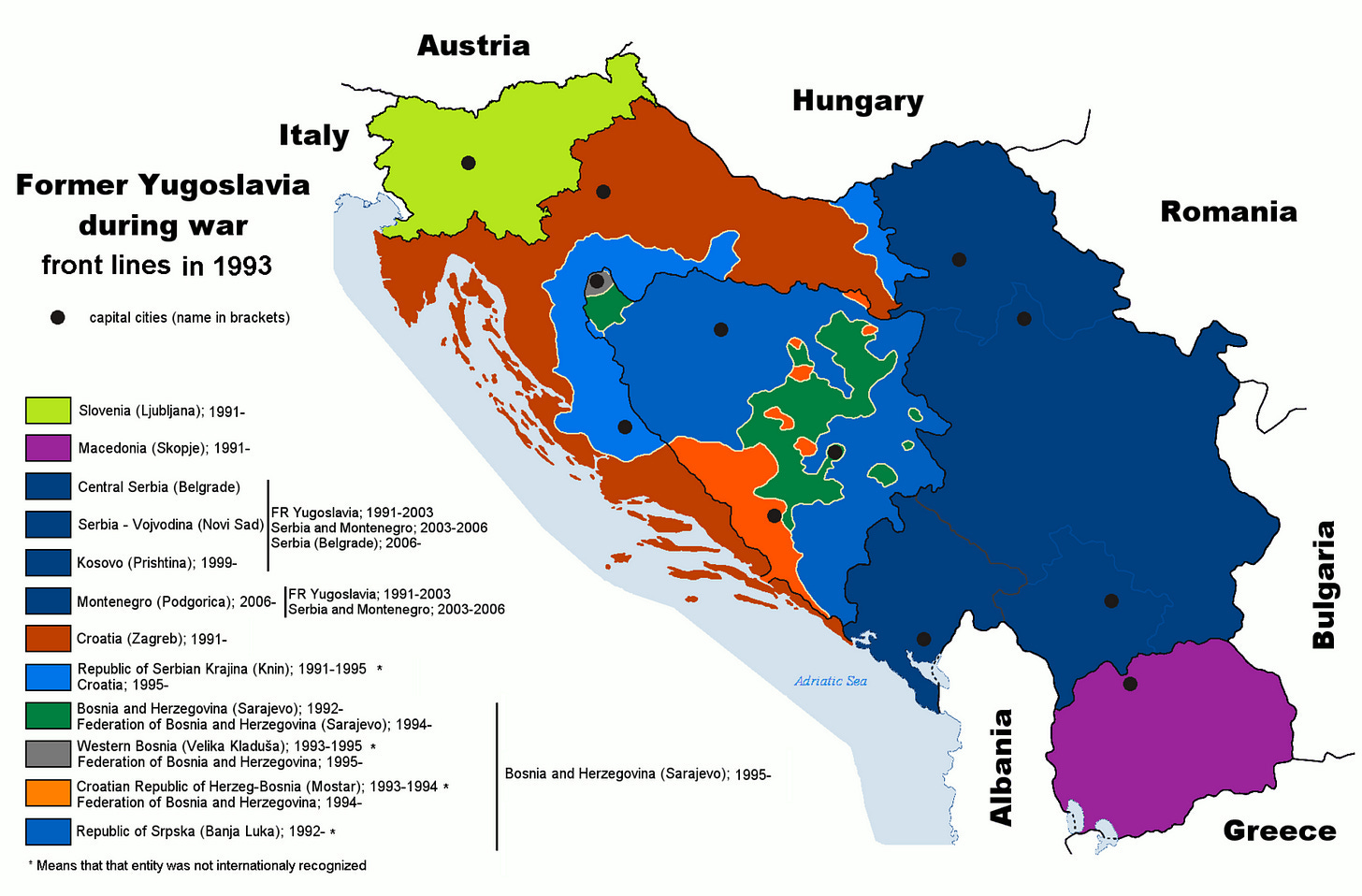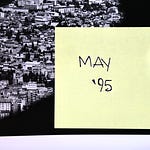June 1993.
The war in Bosnia and Herzegovina is becoming more complicated. Everything that was true just a few months ago is no longer relevant, both on the ground and diplomatically [you can listen to the latest episode of BarBalkans - Podcast here].
Violence has become overwhelming between Bosnian Croats and Bosniaks in Central Bosnia, where the city of Mostar is at the center of armed clashes.
As Bosnian Serbs continue to siege the cities in Eastern Bosnia, a clash with Belgrade has emerged as a result of Republika Srpska’s opposition to the Vance-Owen Plan.
However, this peace plan is now put aside even by the international community. The priority of the new Action Plan is the end of the war, not the territorial integrity of Bosnia.
This is how the President of Serbia, Slobodan Milošević, gains strength both on the international scene and in the domestic political arena, where he starts purging his opponents.
Milošević’ iron fist
In late May, Milošević has forced the President of the Federal Republic of Yugoslavia, Dobrica Ćosić, to resign. And now he continues to crack down internal dissent in Belgrade.
On June 1st, the leader of the Serbian Renewal Movement (SPO), Vuk Drašković, organizes a demonstration against the Serbian President, showing that the monarchist and democratic opposition is still alive.
The reaction is not only a brutal repression of the rally, but also a police special forces’ operation to arrest Drašković and his wife Danica at the SPO headquarters.
Vuk and Danica Drašković are heavily beaten and sentenced to prison for subversive activity. This is a message from Milošević to the population: the iron fist has not softened and is always ready if necessary.
Only the hunger and thirst strike combined with a trip to Belgrade by French first lady, Danielle Mitterand, grants Milošević’ pardon.
But the climate of repression is still up and running.
Military operations in Central and Eastern Bosnia
Meanwhile, Bosnian Serbs continue their advance in Eastern Bosnia along the Drina River. The attacks are focused on Goražde, before the entry into force of Resolution 836 (approved on June 4), which formalizes the «protected areas».
The town on the Drina River is surrounded by Ratko Mladić’ Republika Srpska Army, with reinforcements also from Russian nationalists and soldiers from Belgrade. A demonstration that the sanctions imposed by Serbia and Montenegro against Republika Sprska are worthless.
In the city populated by nearly 80 thousand people - including citizens and displaced people - the corpses remain on the ground for days among artillery and building remains.
In Central Bosnia, where the Bosnian Croats have unleashed a violent offensive in the last two months, the Bosniaks (the Muslims of Bosnia) are reorganizing.
On their side, they can count both on numbers - the Army of the Republic of Bosnia and Herzegovina is ten times larger than the Army of the Croatian Republic of Herzeg-Bosnia - and on the motivation “fight or die”.
After occupying Travnik, they extend operations to Gornji Vakuf, Bugojno and Prozor and consolidate control over the left bank of the Neretva River in Mostar.
The counteroffensive is characterized also by ethnic hatred, with summary executions and destruction of Catholic buildings, such as the 19th-century Franciscan monastery at Guča Gora (near Travnik).
The 7th Brigade of the 3rd Army Corps, based in Zenica, is responsible for the most heinous episodes. Its members are fanatic soldiers, survivors of Serbian prison camps and mercenaries from Islamic countries.
An attempt is made in Sarajevo to contain the bad reputation of the Army of the Republic of Bosnia and Herzegovina, with the dismissal of the chief of staff, Šefer Halilović. He is poorly tolerated by the Bosnian President, Alija Izetbegović, for his reputation of a particularly tough commander.
On June 8, he is replaced by General Rasim Delić, together with Bosnian Serb Colonel Jovo Divjak and Bosnian Croat Colonel Stjepan Šiber. This is also an attempt to show that the Republic of Bosnia is not the expression of a single ethnic group.
The Milošević-Tuđman proposal
However, the situation has changed completely from just a few months ago. The Bosnian offensive clashes with an international diplomatic initiative that has new different interests about the situation in the Balkans.
This is shown by the NATO Summit in Athens on June 10-12. Even for the North Atlantic Alliance it is no longer a priority to counter Serbian gains.
Milošević is winning on all fronts. And he seizes the opportunity to give the final diplomatic blow.
The Serbian President contacts again his Croatian counterpart, Franjo Tuđman, for an irresistible proposal.
Support for the ethnic division project in Bosnia in exchange for the ‘return’ of Krajina to Zagreb (although the Croatian Serbs in the region reiterate their desire to unite with Republika Srpska).
The new secret proposal is based on Karađorđevo Agreement in March 1991, as the premise is still the same: the creation of Greater Serbia and Greater Croatia.

The effects of this agreement can be seen in Central Bosnia, where Bosnian Serb and Bosnian Croat troops initiate a cooperation on the ground.
But the main outcome is in Geneva, on June 16.
At the the International Conference on the former Yugoslavia, Milošević and Tuđman officially present the proposal to divide Bosnia and Herzegovina into three ethnically homogeneous States.
A Republika Srpska, a Croatian Republic of Herzeg-Bosnia, and a Muslim Republic.
The three Republics will be bound by a confederal agreement and a symbolic central authority, but they will have their own Constitution, government and police force (but no army, because of the demilitarization sanctioned by the proposal).
The Muslim Republic will receive less than 20% of Bosnian territory, divided into two separate ‘islands’: one in Central Bosnia (around Sarajevo, Tuzla and Zenica) and one in Northwestern Bosnia (in the Bihać area).
Access to the sea is granted through the free port of Ploče (in Dalmatia), but in exchange for the complete evacuation of the towns along the Drina River (Goražde, Žepa, Srebrenica and Zvornik).
A complicated Realpolitik
International diplomacy welcomes the new proposal. This is considered the result of the Realpolitik followed after the failure of the Vance-Owen Plan.
The green light from the United States, Russia, the United Kingdom and France is the final tombstone on the peace plan first presented on January 2.
The major international powers are openly in favor of a solution that will end the war, even if it requires to sacrifice the integrity of Bosnia and Herzegovina and ‘legalize’ the territories gained through force and ethnic cleansing by the Serbs.
However, the European Community is divided. On one side there is the French President, François Mitterrand, who is convinced that Bosniaks are exhausted and therefore willing to negotiate. On the other side there is the German chancellor, Helmut Kohl, who tries to convince the other 11 Heads of State to lift the arms embargo, allowing the Muslims to defend themselves.
But the situation in Bosnia has completely changed from the first half of the year.
Until May, Bosniaks and Bosnian Croats were in favor of the Vance-Owen Plan, while Bosnian Serbs were strongly opposed. Now, it is the complete opposite: the Milošević-Tuđman proposal encounters only Bosniaks’ opposition.
The partition of Bosnian territory discriminates against Muslims and formalizes ethnic cleansing. More importantly, it comes at a favorable time for Bosnian forces: they have secured significant victories against the Serbs at Bričko and Goražde and against the Croats at Busovača and Vitez.
This is why Bosnian President Izetbegović leaves Geneva on June 20, particularly displeased with the proposal endorsed by the international community. He can only reserve the right to give his last word after a consultation in Sarajevo with the collective Presidency.

If you know someone who can be interested in this newsletter, why not give them a gift subscription?
Here is the archive of BarBalkans - Podcast:
And here you can find a summary of the past years:


















Share this post